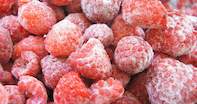Freeze-drying is a highly technical way of food preservation. During this process, frozen foodstuffs are dehydrated under pressure to preserve its nutrition and flavour.

It is used by the USA’s National Aeronautics and Space Administration (NASA) to prepare food for astronauts but also widely available in supermarkets and retail stores.
Freeze-dried foods are easily rehydrated by adding water.
Freeze-drying was invented by Jacques-Arsene d’Arsonval in Paris in 1906 and was later used during World War II to preserve blood serum. In the 1950s the industrial freeze-drying of foods began and now in the 2020s, freeze-dried products include fruit, meat and instant drinks as well as ready-meals for campers, adventurers, soldiers and astronauts.
The Freeze-Drying Process
The technical term for freeze-drying is lyophilization.
Freeze-drying is the process by which water (or the suspension medium) is crystallized at low temperature and removed by sublimation. Sublimation is the direct transition of water from solid state (ice) to a gaseous state (vapour) without melting and becoming a liquid.
Sublimation in the freeze-drying process can be described in three steps; freeze, vacuum and dry.
In the initial step of the freeze-drying process, the product is first deep-frozen at normal pressure. It is important to freeze foods quickly. Slow freezing creates large ice crystals which damage the internal cell structure and negatively affects the final product quality.
The second step is placing the frozen product under vacuum and thirdly, heat is applied to provide the energy for the ice to turn to vapour. Water vapour is collected in special condensers. This drying phase removes about 95% of the water and can take from several hours to two days. A secondary drying process with increased temperatures removes unfrozen water molecules from the product.
The final freeze-dried food typically contains between 1% and 4% moisture. Well-controlled freeze-drying leaves nutrients largely unaffected and only causes slight alteration to the internal structure of the food. The dried cells within the product now have a sponge-like structure which absorbs moisture rapidly when the product is rehydrated.
After freeze-drying, food products are packed in special pouches or cans which are then flushed with nitrogen gas to remove oxygen.
Freeze-Dried Foods
Examples of freeze-dried foods include meat, spices, powdered milk, cheese, eggs, fruit and instant drinks such as coffee granules, tea and smoothies. Fruit makes up the largest portion (over 30%) of the freeze-dried market, but increasingly ready-meals including pasta, soups, stews and desserts.
Fruit and meat are cut into smaller pieces prior to freeze-drying and are available as freeze-dried chunks or mince. Meat, seafood and ready-meals are cooked before freeze-drying and only require the addition of water to prepare.
Benefits of Freeze-Drying
Freeze-drying preserves flavour, colour, structure and appearance of the food product while limiting damage to heat-sensitive nutrients. Tests evaluated foods dehydrated by different drying methods - convective, vacuum, freeze and osmotic drying - and found the best flavour in freeze-dried products.
Freeze-dried products are typically crisper and have rehydration ratios four to six times better (can absorb more moisture) than air-dried food products. They are nutritious, tasty and lightweight - ideal for adventure-style sport and easy to ship for use in emergencies.
In addition, freeze-drying extends the shelflife of fresh products and ready-meals from between 6 months and 3 years in polybags to longer than 25 years in cans.
Cost is the main disadvantage of freeze-drying due to high energy consumption and maintenance.
By Marinda Louw